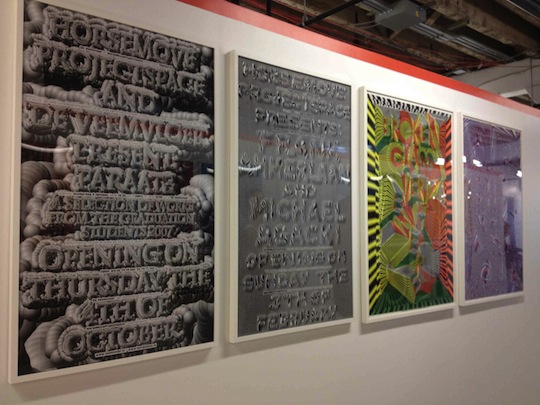
Michael Schuurman
Just thinking about graphic design, and everything that it encompasses, can sometimes make your head spin. To tackle it in its entirety is a daunting task, which is the reason why so few curators and museums have even attempted this tricky venture. Graphic design can be seen as both a process, tool and discipline. The Graphic Design: Now in Production exhibition, which was open to the public this summer in Building 110 on Governors Island and curated by Andrew Blauvelt of the Walker Art Center in Minneapolis and Ellen Lupton of the Cooper-Hewitt, National Design Museum attempted to give a broad overview of design production in the past decade.
One of the most interesting factors which make up graphic design is its connection to both high art and commerce. As Martha Schwendener mentioned in her article for the New York Times graphic design has always oscillated between these two extremes. This split is visible in this exhibition as well. A lot of the work that was specifically commissioned for the exhibition experiments with the medium, involves innovative approaches which expand the field of design, and often moves away from the commercial realm into the service of politics and social change. Yet it is the show’s connection with consumerism that really engages the visitors.

Aware of the connection between graphic design and commerce, the curators purposefully incorporated some aspects of the commercial in their display. For instance, they placed a tiny shop at the beginning and end of the exhibition referencing the usual commercial practices of museums and, as the curators themselves said, Banksy’s documentary Exit Through the Gift Shop. This is only partially successful, as the shop is very unassuming and looks more like a ticket counter that appears to sell little other than the rich 240-page exhibition catalog. But in the show itself, it is the commercial work that often seems the strongest. Their message and aesthetics simple and direct, it is easy to see how they manage to grab the attention of customers. This is particularly evident in the many alternative magazines that manage to push the boundaries of graphic design. This relates to another issue, the proliferation of magazines and books in a time when publishing is thought to be in a steady decline. The savior of publishing appears to be none other than the Internet, the original culprit for its fall. As the curator Ellen Lupton herself said “Now, yes, you can publish your own book, but then you use the Internet to tell people about it. The very thing that was supposed to kill print is providing it with health insurance.”
The exhibition also attempts to establish instant commentary with its audience by engaging it every step of the way. From voting booths, which may in form recall Haacke’s MOMA poll, and internet polls and websites (bringing along change with it as well, such as in the case of the clothing company Gap where harsh commentary from the public forced the company to go back to its original logo). It is interesting to note that most before versions of logos went head to head with the new ones. We are left to wonder if this tells us more about the quality of the logos or the initial reluctance on the part of the public to accept any change. The exhibition also allows visitors to make their own posters and carry a piece of the exhibition home by printing out their slogans using font and software developed by Jurg Lehni.
The one thing that marks this exhibition is that although the display is somewhat traditional, following different genres of graphic design makes the visual experience very chaotic. The sheer barrage of visual information that confronts the viewer is in some way analogous to the variety which can be found in both contemporary life and design. But while the exhibition was open it was interesting to see how well the visitors coped with the visual noise, telling us even more about the way we experience our everyday surroundings.
Further reading:
http://www.metropolismag.com/story/20120608/the-heart-of-the-matter
Tags: Exhibitions